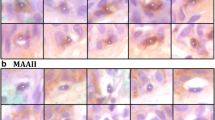Summary
The Langerhans cell appears to be a common and essential element of healthy human skin displaying fine-structural and histochemical evidence of intense metabolic activity throughout the living epidermis. Even the tiny cell processes reaching the granular layer contain mitochondria, agranular endoplasmic reticulum, and rods, the specific products of the Langerhans cell. Also the elaborate Golgi-complex and the large surface-area of the lobulated nucleus reflect high synthetic activity.
The Langerhans cell is not a worn-out melanocyte but a highly productive, probably secretory cell. Within the limitations of static morphology the prevailing hypothesis that the Langerhans cell represents an ascending derivative of a previously pigment producing melanocyte seems unwarranted.
Similar content being viewed by others
References
Birbeck, M. S., A. S. Breathnach, and J. D. Everall: An electron microscope study of basal melanocytes and high-level clear cells (Langerhans cells) in vitiligo. J. invest. Derm. 37, 51–64 (1961).
Breathnach, A. S.: A new concept of the relation between the Langerhans cells and the melanocyte. J. invest. Derm. 40, 279–281 (1963).
—: Observations on cytoplasmic organelles in Langerhans cells of human epidermis. J. Anat. (Lond.) 98, 265–270 (1964).
— T. B. Fitzpatrick, and L. M.-A. Wyllie: Electron microscopy of melanocytes in human piebaldism. J. invest. Derm. 45, 28–37 (1965).
—, and D. P. Goodwin: Electron microscopy of non-keratinocytes in the basal layer of white epidermis of the recessively spotted guinea pig. J. Anat. (Lond.) 99, 377–387 (1965).
Drochmans, P.: Etude au microscope électronique du mécanisme de la pigmentation mélanique. Arch, belges Derm. 16, 155–163 (1963).
—: Melanin granules: their fine structure, formation and degradation in normal and pathological tissues. Int. Rev. exp. Path. 2, 357–422 (1963).
Fawcett, D. W.: An atlas of fine structure. The cell, its organelles and inclusions. Philadelphia: W. B. Saunders Co. 1966.
Ferreira-Marques, J.: Systema sensitivum intra-epidermicum. Arch. Derm. Syph. (Berl.) 193, 191–250 (1951).
Langerhans, P.: Über die Nerven der menschlichen Haut. Virchows Arch. path. Anat. 44, 325–337 (1868).
Luft, J. H.: Improvements in epoxy resin embedding methods. J. biophys. biochem. Cytol. 9, 409–414 (1961).
Mishima, Y.: Melanosomes in phagocytic vacuoles in Langerhans cells. J. Cell Biol. 30, 417–423 (1966).
Mustakallio, K. K.: Adenosine triphosphatase activity in neural elements of human epidermis. Exp. Cell Res. 28, 449–451 (1962).
Niebauer, G.: Über die interstitiellen Zellen der Haut. Hautarzt 7, 123–126 (1956).
—, u. N. Sekido: Über die Dendritenzellen der Epidermis. Eine Studie über die LangerhansZellen in der normalen und ekzematösen Haut des Meerschweinchens. Arch. klin. exp. Derm. 222, 23–42 (1965).
Palade, G. E.: A study of fixation for electron microscopy. J. exp. Med. 95, 285–298 (1952).
Reynolds, E. S.: The use of lead citrate at high pH as an electron opaque stain in electron microscopy. J. Cell Biol. 17, 208–212 (1963).
Sabatini, D. D., K. Bensch, and J. Barrnett: Cytochemistry and electron microscopy. The preservation of cellular ultrastructure and enzymatic activity by aldehyde fixation. J. Cell Biol. 17, 19–58 (1963).
Thies, W.: Über die Brauchbarkeit einer modifizierten Osmiumjodidmethode zur Darstellung des Nervensystems der Haut. Hautarzt 13, 12–18 (1962).
Zelickson, A. S.: The Langerhans cell. J. invest. Derm. 44, 201–212 (1965).
Author information
Authors and Affiliations
Additional information
Acknowledgement. We are indebted to Miss Tellervo Huima for the preparation of the electronmicroscopic specimens and to the Finnish Medical Research Council for a grant.
Assistant of the Finnish Medical Research Council.
Rights and permissions
About this article
Cite this article
Kiistala, U., Mustakallio, K.K. Electronmicroscopic evidence of synthetic activity in Langerhans cells of human epidermis. Z. Zellforsch. 78, 427–440 (1967). https://doi.org/10.1007/BF00325322
Received:
Issue Date:
DOI: https://doi.org/10.1007/BF00325322




